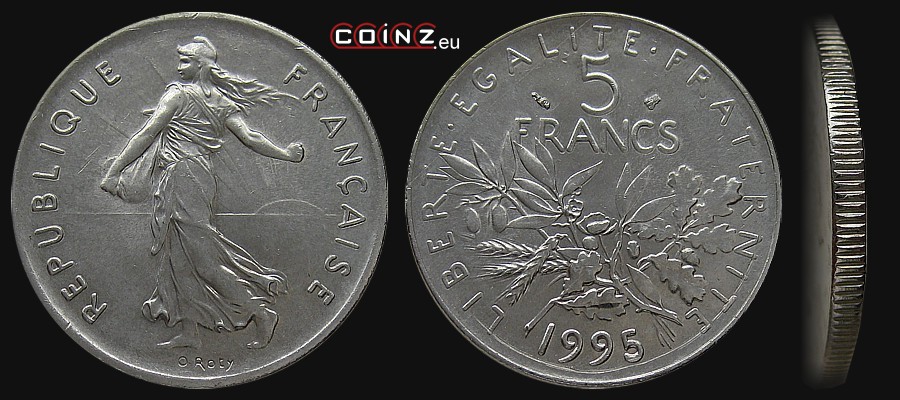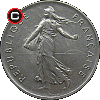5 francs FRANCE (1970-2001)


| diameter: | weight: | thickness: | alloy: |
| 29.0 mm | 10.0 g | 2.1 mm | Cu75Ni25 Ni-plated |
obverse:
in coin centre personification of France - figure of Marianne in Phrygian cap sowing cereal leftwards (La Semeuse), in the background the Sun hidden mostly below the horizon; along the left edge: REPUBLIQUE, along the right: FRANÇAISE (French Republic)
reverse:
in the coin centre olive and oak branches together with cereal ears; above in two lines face value: 5 / FRANCS; along the bottom edge year of issue; along the top edge motto of France: LIBERTE • EGALITE • FRATERNITE (liberty, equality, fraternity)
edge:
reeded
issue date:
24 IX 1969
withdrawal date:
18 II 2002
designer:
Atelier de gravure (group of designers of the Paris Mint) based on design of Louis Oscar Roty (signature O.ROTY on the bottom of the obverse)
mint:
 La Monnaie de Paris (The Paris Mint), Paris (until 1972) or Pessac (from 1973) (mint mark before face value 5 in the reverse, after face value 5 privy mark of mint's director Raymond Joly - owl - in years 1970-1974, Emile Rousseau - dolphin - in years 1975-1994, Pierre Rodier - bee - in years 1994-2000 or Gérard Buquoy - horseshoe - in 2001)
La Monnaie de Paris (The Paris Mint), Paris (until 1972) or Pessac (from 1973) (mint mark before face value 5 in the reverse, after face value 5 privy mark of mint's director Raymond Joly - owl - in years 1970-1974, Emile Rousseau - dolphin - in years 1975-1994, Pierre Rodier - bee - in years 1994-2000 or Gérard Buquoy - horseshoe - in 2001)

mintage:
| 1970 | 57 890 000 | owl | + 10 000 in annual boxed sets |
| 1971 | 142 204 000 | owl | + 12 000 in annual boxed sets |
| 1972 | 45 492 000 | owl | + 15 000 in annual boxed sets |
| 1973 | 45 079 000 | owl | + 79 000 in annual boxed sets |
| 1974 | 26 888 000 | owl | + 98 800 in annual boxed sets |
| 1975 | 16 712 000 | dolphin | + 52 000 in annual boxed sets |
| 1976 | 1 662 000 | dolphin | + 37 500 in annual boxed sets |
| 1977 | 485 000 | dolphin | + 25 000 in annual boxed sets |
| 1978 | 30 022 000 | dolphin | + 24 000 in annual boxed sets |
| 1979 | 10 000 | dolphin | + 40 500 in annual boxed sets |
| 1980 | - | dolphin | + 60 000 in annual boxed sets |
| 1981 | 24 000 | dolphin | + 26 000 in annual boxed sets |
| 1982 | 32 200 | dolphin | + 27 500 in annual boxed sets |
| 1983 | 84 400 | dolphin | + 16 561 in annual boxed sets |
| 1984 | 36 400 | dolphin | + 13 836 in annual boxed sets |
| 1985 | 7 600 | dolphin | + 12 500 in annual boxed sets |
| 1986 | - | dolphin | + 15 000 in annual boxed sets |
| 1987 | 19 993 967 | dolphin | + 11 956 in annual boxed sets |
| 1988 | 85 000 | dolphin | + 10 565 in annual boxed sets |
| 1989 | 83 000 | dolphin | + 11 438 in annual boxed sets |
| 1990 | 15 000 011 | dolphin | + 10 000 in annual boxed sets |
| 1991 | 7 488 011 | dolphin | + 2 500 in annual boxed sets |
| 1992 | 9 966 011 | dolphin | + 2 698 in annual boxed sets |
| 1993 | 14 970 011 | dolphin | + 3 095 in annual boxed sets |
| 1994 | 6 000 000 | dolphin | |
| 1994 | 3 973 818 | bee | + 3 707 in annual boxed sets |
| 1995 | 19 990 011 | bee | + 4 000 in annual boxed sets |
| 1996 | 12 000 | bee | + 5 000 in annual boxed sets |
| 1997 | - | bee | + 15 000 in annual boxed sets |
| 1998 | - | bee | + 25 000 in annual boxed sets |
| 1999 | - | bee | + 25 000 in annual boxed sets |
| 2000 | - | bee | + 100 000 in annual boxed sets |
| 2001 | - | horseshoe | + 125 000 in annual boxed sets |
varieties:
In years 1991, 1992 and 1993 there exist coins with reverses not rotated by 180° in respect to obverses (medal alignment in American terminology) - 2500, 2698 and 3095 pieces were produced in respective years and placed in annual boxed sets;
in annual boxed sets from years 1991-2001 instead of the designer's signature O.ROTY there is inscription: D'AP O.ROTY (D'APRÉS OSCAR ROTY - based on Oscar Roty);
1994 - coins with a privy mark of mint's director Emile Rousseau dolphin or with the privy mark of Pierre Rodier bee
in annual boxed sets from years 1991-2001 instead of the designer's signature O.ROTY there is inscription: D'AP O.ROTY (D'APRÉS OSCAR ROTY - based on Oscar Roty);
1994 - coins with a privy mark of mint's director Emile Rousseau dolphin or with the privy mark of Pierre Rodier bee
mint marks:
interesting facts:
last update: 20 XI 2013
coins catalogue :: katalog monet :: münzkatalog :: catalogue de monnaies :: catálogo de monedas :: catalogo monete :: каталог монет :: κέρματα κατάλογος :: COINZ.eu
© 2010-2025 :: Adam Kubicki :: COINZ.eu :: All rights reserved.


